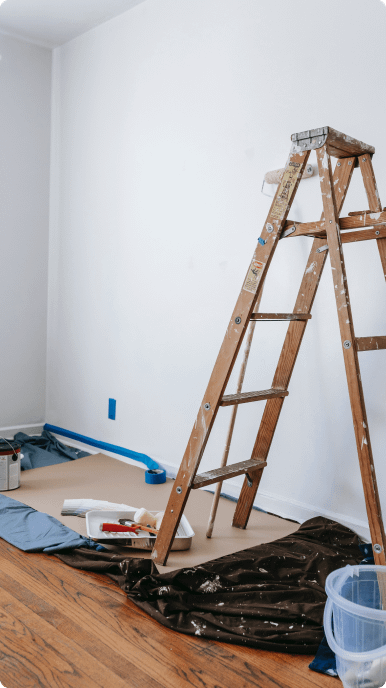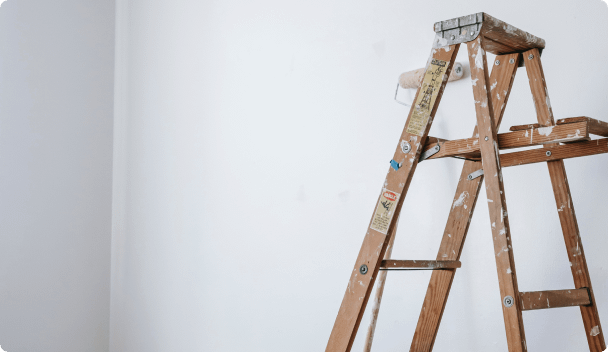Drywall is a common material in Illinois homes and businesses, providing a smooth and versatile surface for painting. However, it’s also susceptible to damage. From minor dings to significant holes, drywall repair is a frequent need. At Allegiant Painting, serving McHenry and the surrounding areas, we believe in empowering homeowners and businesses with knowledge. This guide will explore the different types of drywall damage, outline basic DIY repairs, and, importantly, explain when it’s best to call a professional drywall repair service in Illinois.
Common Types of Drywall Damage
Drywall damage comes in many forms, and understanding what you’re dealing with is the first step to fixing it. Here’s a rundown of common issues we see in Illinois:
- Nail Pops: These are those annoying little bumps that appear on your walls. They happen when nails or screws that secure the drywall push out slightly. This is often due to the wood framing behind the drywall expanding and contracting with changes in humidity and temperature, something we definitely experience here in Illinois with our seasonal swings.
- Dings and Scratches: Think of these as the everyday wear and tear of life. Moving furniture, kids playing, or just accidental bumps can leave small dings and scratches on your walls.
- Small Holes: These are typically caused by things like doorknobs hitting the wall, hanging pictures, or just general clumsiness. They’re usually less than a few inches in diameter.
- Medium Holes: These are bigger than your fist and can result from plumbing or electrical work, or if something larger impacts the wall.
- Large Holes: This is the most severe damage, often requiring significant patching and structural support. Think of a hole kicked in a wall or damage from a major impact.
- Water Damage: This is a serious one. Water can cause drywall to sag, discolor, and even grow mold. In Illinois, leaky roofs, burst pipes, and flooding are common culprits, and it needs to be addressed quickly.
- Cracks: Cracks in drywall can range from hairline fractures to large, spreading cracks. They can be caused by house settling, temperature changes, or, in more serious cases, foundation problems.
- Textured Wall Damage: Many homes have textured walls. Repairing damage to these walls requires special techniques to match the existing texture, which can be tricky.
DIY Drywall Repair: When to Tackle It Yourself (Illinois Homeowners)
For very minor drywall damage, like nail pops, small dings, and scratches, homeowners with some basic skills and tools can often handle the repair themselves.
Here are the materials and tools you’ll likely need:
- Joint compound (also called “”mud””)
- Drywall tape (mesh or paper)
- Putty knife (various sizes)
- Sandpaper (various grits)
- Primer
- Paint
- Drywall screws
- Utility knife
- Sponge
Here’s a quick rundown of how to tackle some common DIY repairs:
Nail Pops:
- Reset the nail or screw: If it’s sticking out, gently tap it back in or screw it in further.
- Apply joint compound: Use a putty knife to apply a small amount of joint compound over the pop, creating a smooth, even surface.
- Sand: Once dry, sand lightly until smooth.
- Prime and paint.
- Dings and Scratches:
- Clean the area.
- Apply joint compound: Fill the ding or scratch with a thin layer of joint compound.
- Sand: After it dries, sand until smooth and flush with the wall.
- Prime and paint.
Small Holes:
You can use a patch kit (available at most hardware stores) or the “”California patch”” method, which involves creating a patch from a piece of drywall.
- Secure the patch in the hole.
- Apply joint compound over the patch, extending slightly beyond the edges.
- Tape the seams.
- Sand smooth after it dries.
- Prime and paint.
Important Safety Precautions:
- Always wear a dust mask when sanding joint compound, as the dust can irritate your lungs.
- Use caution when working with utility knives and other tools.
When to Call a Pro: Professional Drywall Repair in McHenry County
While some minor repairs are DIY-friendly, there are many situations where it’s best to call in the professionals. Here’s when Allegiant Painting recommends seeking expert help:
- Medium to Large Holes: These require more than just a bit of joint compound. They often necessitate backing boards or other supports to ensure the patch is strong and won’t sag. Professionals have the tools and experience to handle these larger repairs seamlessly.
- Water Damage: Water damage is a serious issue that needs prompt attention. A professional can properly assess the extent of the damage, identify the source of the leak, and prevent further problems. In some cases, mold remediation might also be necessary, which is definitely a job for a specialist.
- Cracks (Especially Large or Recurring): While hairline cracks might seem harmless, large or recurring cracks can indicate structural issues with your home’s foundation. It’s crucial to have these evaluated by a professional to prevent further damage and costly repairs. Even if the cracks are not structural, pros can ensure they are repaired properly to prevent them from reappearing.
- Textured Wall Damage: Matching the texture of existing walls is an art form. Professionals have the specialized tools and techniques to blend the repair seamlessly. DIY attempts often result in noticeable and unsightly patches.
- Extensive Damage: Any damage that compromises the structural integrity of the wall or ceiling should be handled by a professional. This includes situations where large sections of drywall are missing or sagging.
- Time Constraints: Let’s face it, drywall repair can be time-consuming and messy. If you’re busy or simply don’t feel confident in your abilities, calling a pro will save you time and ensure a quality result.
The Advantages of Professional Drywall Repair in Illinois
Hiring a professional drywall repair service like Allegiant Painting offers several key benefits:
- Quality and Durability: Professionals have the expertise and use the right materials and techniques to ensure a long-lasting and durable repair. This is especially important in Illinois, where temperature and humidity fluctuations can put stress on drywall.
- Time Savings: You’ll save valuable time and avoid the hassle of learning new skills and dealing with a potentially messy project.
- Proper Preparation: Professionals understand the importance of thorough surface preparation, which is crucial for a smooth and flawless finish.
- Aesthetics: Professional drywall repair results in seamless patches that blend perfectly with the surrounding wall, leaving no trace of the damage.
- Prevents Further Damage: By correctly addressing the underlying causes of the damage, professionals prevent the problem from recurring and potentially causing more significant issues.
- Safety: Professionals are trained to work safely, especially when dealing with water damage or structural issues.
Conclusion
Understanding the different types of drywall damage and knowing when to tackle it yourself versus calling a professional is crucial for maintaining your Illinois property. At Allegiant Painting, we’re here to help with all your drywall repair and painting needs. Whether it’s a small patch or a major repair, our experienced team provides quality workmanship and reliable service. Contact us today for a free consultation and let us restore your walls to their former glory.”
Drywall Repair FAQs
What are the most common types of drywall damage?
The most common types of drywall damage include nail pops, dings and scratches, small holes, medium holes, large holes, water damage, cracks, and textured wall damage.
What causes cracks in drywall?
Cracks in drywall can be caused by house settling, temperature changes, or in some cases, foundation problems.
How do you fix a small hole in drywall?
You can use a patch kit (available at most hardware stores) or the “”California patch”” method, which involves creating a patch from a piece of drywall.
What tools do I need to repair drywall?
You’ll most likely need the following tools for DIY drywall repair:
- Joint compound (also called “”mud””)
- Drywall tape (mesh or paper)
- Putty knife (various sizes)
- Sandpaper (various grits)
- Primer
- Paint
- Drywall screws
- Utility knife
- Sponge
How much does professional drywall repair cost?
The cost of professional drywall repair varies significantly depending on the size and severity of the damage, but generally ranges from $50 to $75 per square foot. Small holes can be repaired for $50 to $150, while larger patches or extensive repairs can cost $200 to $400 per hole.
What are the signs of structural damage to drywall?
While hairline cracks might seem harmless, large or recurring cracks can indicate structural issues with your home’s foundation


